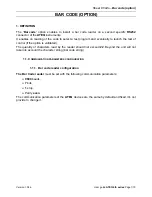
Chapter 1: Terminal Description
Basic Communication
MANU-MAXIMUS-02
Maximus Reference Manual
1-19
Revision-02
Basic Communication
This sections discusses some basic communications functions of the Maximus.
Ethernet Communication Acknowledgement
Maximus terminals support two-way application acknowledgement for Ethernet
communication.
Two-way application acknowledgement (TWAA) ensures both that transactions from the
terminal are received by the host and also that transactions from the host are received by the
terminal. The acknowledgement (ACK) that is sent by the terminal is also sent by the host.
The host application should send an ATS ACK to the terminal in response to all data messages
received from the terminal except the following, which are not acknowledged:
•
An ATS ACK received from the terminal
•
A KeepAlive message received from the terminal
Should there be a connection failure, the terminal will continue from where it left off upon
reconnection. Upon reconnection, the host also continues from where it left off, except when
the terminal resets. In this case, a power-on message transmits, which indicates that the
process needs to be restarted.
KeepAlives
KeepAlives are scheduled communications between network devices that indicate the network
device is still online and active. By default, these communications are sent every 30 seconds. If
KeepAlive communications stop, then the device that is no longer sending KeepAlive
communications is offline or otherwise unavailable.
A KeepAlive uses the unique ID of the terminal (see
Terminal ID on page 1-5
). You can use the
diagnostic window in ATS AccuEngine™ (see the
Accu-Engine Terminal Management Utilities
User Guide
), or other communication software, to see KeepAlives.
•
In static addressing mode, the KeepAlive is:
ATSnnnnnn
»
S
(the terminal’s unique
ID with a
»
(record separator) and an S for static mode)
•
In dynamic addressing mode, the KeepAlive is:
ATSnnnnnn
»
D
(the terminal’s
unique ID with a
»
(record separator) and a D for dynamic mode)
















































